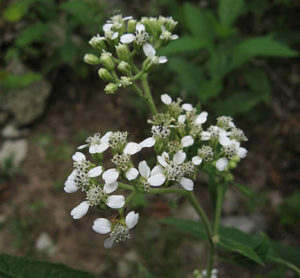
When we think about early winter interest in the garden or landscape, we are often thinking about trees or shrubs that have interesting bark or brightly colored berries. Native grasses can also provide early winter interest with their golden browns and attractive seedheads. However, rarely do we think about herbaceous plants as a source of that early winter interest. That’s where white wingstem comes in.
White wingstem (Verbesina virginica), aka white crownbeard, aka frostweed, aka frostflower, is a native, fall-blooming, perennial wildflower. It is a great late season source of nectar and pollen for bees and butterflies, including monarchs, cloudless sulphurs, and other migrating butterflies. Then as the temperatures plummet, white wingstem puts on a secondary display of frost flowers.
What’s in a Name?
White wingstem gets its common name of “wingstem” because it has long, leafy outgrowths running up and down its stem, especially on the lower 2/3 of the stem. Those leafy outgrowths are the stem’s “wings.” The “white” in the name “white wingstem” refers to the color of its flowers and distinguishes it from other species in this genus that have yellow flowers.
The common names of “frostweed” or “frostflower” come from the fact that this is one of the few plants that produces frost flowers. Frost flowers are a fascinating and fairly unique phenomenon that can be observed on the first really cold nights of the year. (See below for more information about frost flowers.)
Biology and Life History
White wingstem is native to most of the eastern half of the U.S. It can be found growing in the wild in medium to slightly moist, open woodlands and fields. It grows fairly tall, often reaching 5 feet, but can grow even taller.
In the late fall, it produces flat topped clusters of white flowers. (This typically happens from August through October in Kentucky.) After blooming, the flowers produce abundant seeds that tend to stay on the plant into the early winter or even later, depending on how quickly the birds find them.
Pollinator and Wildlife Uses
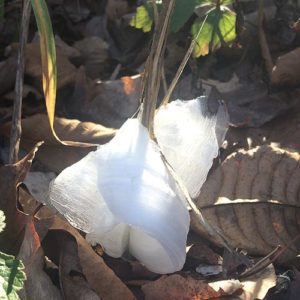
Honey bees, native bees, and butterflies love white wingstem (and other Verbesina species). Because it blooms so late in the season, white wingstem can provide a valuable source of nectar and pollen before the killing frosts start. In some areas of the country, like Texas, it is considered one of the top late fall nectar sources for migrating monarchs.
White wingstem vegetation is also a host plant for the silvery checkerspot (Chlosyne nycteis) caterpillar and the summer azure caterpillar (Celastrina neglecta). Deer tend not to eat white wingstem, especially if there are other things to eat. Finches, sparrows, and other songbirds eat the abundant seeds throughout the winter.
The Frost Flower Phenomenon
Despite the name, frost flowers are neither frost, nor flowers. Instead, they are frozen sap. Frost flowers are a fairly unique phenomenon that are only produced by a small handful of plants. No one seems to be sure why most species of plants don’t produce frost flowers, but some do. White wingstem produces copious frost flowers and is one of the best known producers of frost flowers in the eastern U.S.
Frost flowers occur when the air temperature dips below freezing but the ground remains moist and unfrozen. This typically happens in late fall / early winter, but in some years and some locations you can find scattered frost flowers well into mid-winter. Frost flowers are created when the sap freezes inside the stem of certain herbaceous plants.
Since liquids expand as they freeze, the freezing sap splits the stem. The sap slowly leaks out the stem, freezing instantly as it hits the cold air and forming ribbons of ice known as frost flowers. Sometimes the frost flowers are thick and chunky. Other times they are thin and curly. I most often find them only a few inches from the ground, but occasionally you can find them much higher up on the stem. Like snowflakes, each frost flower is unique. As the temperature warms up, the frost flowers melt and disappear.
Incorporating White Wingstem into Your Yard
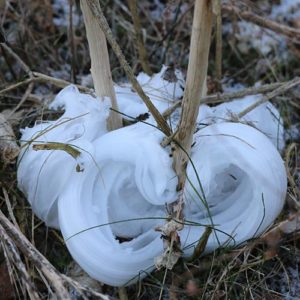
White wingstem grows well in medium to moist soil and part sun conditions. Once established it is easy to grow. White wingstem can spread both through the abundant seeds it produces and by rhizomes. In a small space, it can become aggressive and take over within a few years.
Because white wingstem does tend to be on the aggressive side, and also because it tends to get fairly tall, it is perhaps best planted in larger, less formal garden settings or pollinator plots. It needs room to spread and to be with other fairly aggressive plants so that each species can hold its own against its neighbors.
If you want to grow white wingstem in your garden or pollinator planting, then you’ll have to go to a native plant nursery or native seed producer. I’ve never seen it for sale in the traditional horticulture trade. White wingstem seeds are probably going to be easier to find than white wingstem plants.
Summary
White wingstem is a great, late blooming, native plant to grow in pollinator gardens, but it can be aggressive in small settings. It is best grown in larger, less formal garden settings where its tendency to spread won’t create problems. In addition to all the benefits it provides pollinators and wildlife, it also has the added benefit of creating fascinating and unique frost flowers each winter for us to enjoy.
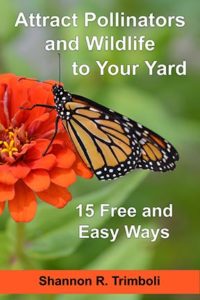
Do you want to make your yard more pollinator and wildlife friendly, but aren’t sure where to start?
Check out my book, Attract Pollinators and Wildlife to Your Yard: 15 Free and Easy Ways, for some easy, quick wins to get you started.
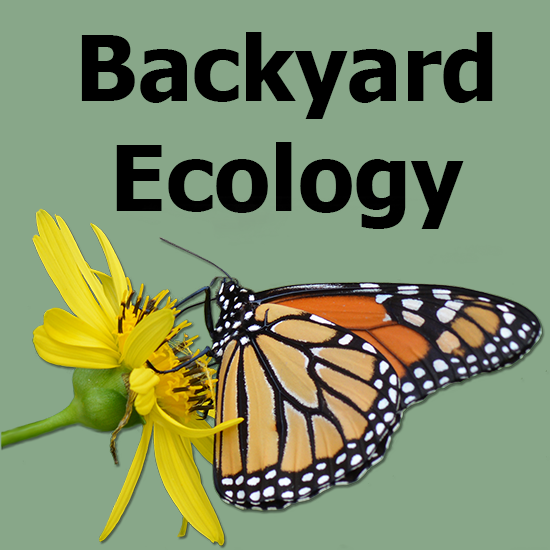
Backyard Ecology: Exploring Nature in Your Backyard
Nature isn’t just “out there.” It’s all around us, including right outside our doors. Hi, my name is Shannon Trimboli, and I am the host of Backyard Ecology. I live in southcentral Kentucky and am a wildlife biologist, educator, author, beekeeper, and owner of a nursery specializing in plants for pollinators and wildlife conservation. I invite you to join me as we ignite our curiosity and natural wonder, explore our yards and communities, and improve our local pollinator and wildlife habitat. Learn more or subscribe to my email list at www.backyardecology.net.
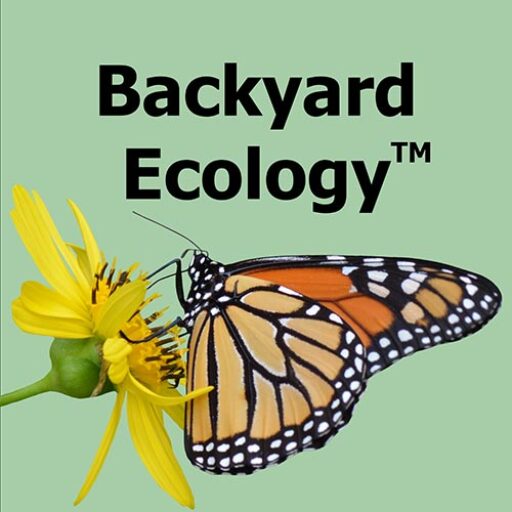
Leave a Reply